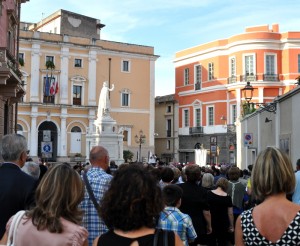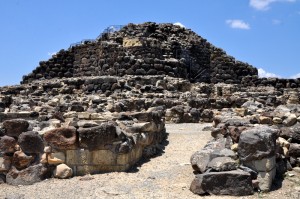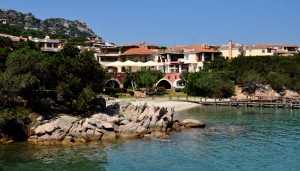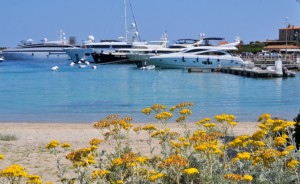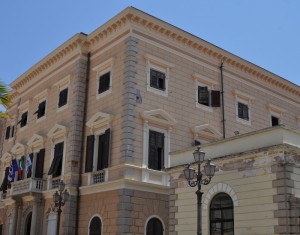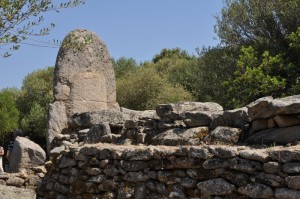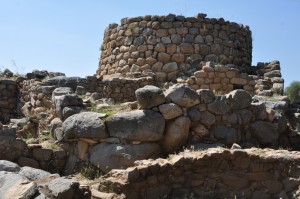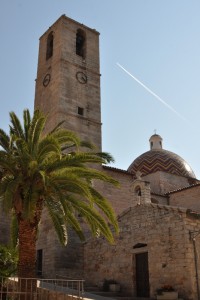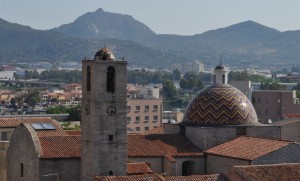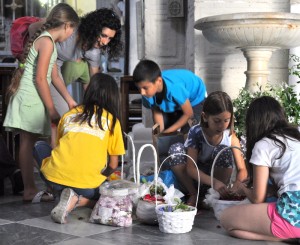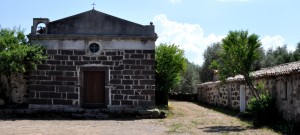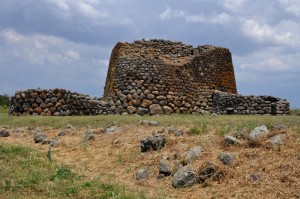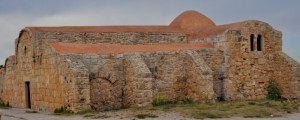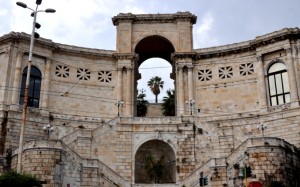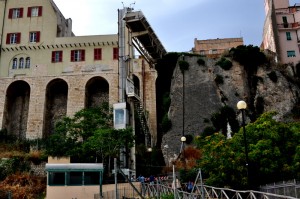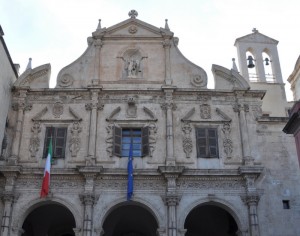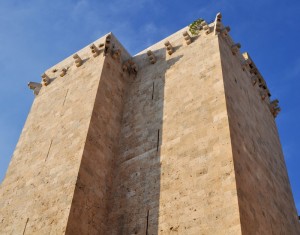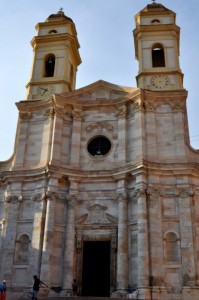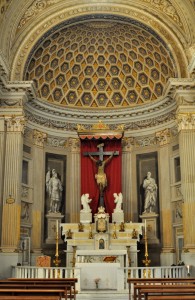June 5-10: Sardinia – Olbia, Oristano & Cagliari
June 5 Friday: Oblia, Sardinia
Sardinia, one of the most geologically ancient bodies of land in Europe, is the second largest island (after Sicily) in Italy with an area of 23,821km² and a coastline of 1,849km in the Mediterranean Sea. Divided into eight provinces, it is an autonomous region with a population of 1.7 million (2014 est).
History of Sardinia
Sardinia was populated in various waves of emigration from prehistory until recent times. The first people to settle in the island came from the Iberian and the Italian peninsula. In the mid Neolithic period, the Ozieri culture probably of Aegean origin flourished on the island followed by the Beaker culture coming from Continental Europe during the early Bronze Age.
![karte-1-1014[1]](http://www.sarahontheroad.hk/wp-content/uploads/2015/06/karte-1-10141-251x300.gif) From about 1500 B.C. onwards, the Nuraghe civilisation linked with other contemporaneous megalithic civilisation of the western Mediterranean, emerged on the island. Villages were built around round tower-fortresses called nuraghe. Today some 7,000 nuraghes still remain standing. While most of them are simple structures, a few complex and monumental nuraghes, several Giants’ graves (monumental collective tombs) and sacred wells exemplify this distinct culture with Su Nuraxi near Barumini being designated a World Heritage Site.
From about 1500 B.C. onwards, the Nuraghe civilisation linked with other contemporaneous megalithic civilisation of the western Mediterranean, emerged on the island. Villages were built around round tower-fortresses called nuraghe. Today some 7,000 nuraghes still remain standing. While most of them are simple structures, a few complex and monumental nuraghes, several Giants’ graves (monumental collective tombs) and sacred wells exemplify this distinct culture with Su Nuraxi near Barumini being designated a World Heritage Site.
Phoenician colonists founded the city of Tharros in the Sinis peninsula in the 8th century B.C. Then the Carthaginians arrived two centuries later. In 238 B.C. Sardinia became a Roman province and annexed by the Byzantine Empire in 534. In the Early Middle Ages, through barbarian movements, waning influence from the Byzantine Empire and the Saracen raids, the island fell out of the sphere of influence of any higher government. This led to the birth of four kingdoms called Giudicati (sort of hereditary lordship) beginning in 8th century. By the 10th century, there were five known Giudicati. Falling under papal influence, Pope Boniface VIII established in 1297,on his own initiative a hypothetical regnum Sardiniae et Corsicae (“Kingdom of Sardinia and Corsica”) in order to settle diplomatically the War of the Vespers which broke out between the Angevins and Aragonese over the possession of Sicily in 1282. The Pope offered this new kingdom to James II of Aragon. Sardinia became the focus of the rivalry of Genoa and Pisa. The Giudicati and the Crown of Aragon eventually subsumed the island in 1324 as the Kingdom of Sardinia which remained Spanish for 400 years.
In 1718, Sardinia was handed, as a result of the Treaty of London, over to the Piedmontese House of Savoy which imposed the Italian language on the island in 1760. In 1799, as a consequence of the Napoleonic Wars in Italy, the Dukes of Savoy left Turin and took refuge in Cagliari for some fifteen years. In 1861, Sardinia became part of the Kingdom of Italy and finally in 1946 the Italian Republic.
Sardinia has had a rough time. Famines in the 16th century once took away a third of its population. Malaria was only successfully eliminated in 1951. Political instability as a result of emerging Sardinian nationalism and local protest movements which became stronger in the 1970s led to a series of terrorist actions and kidnappings by bandits which ended only in the 1990s. The economic efforts of the last twenty years have reduced the handicap of insularity, especially in the fields of low-cost air travel and advanced information technology. Today Sardinia is phasing in as an EU region, with a diversified economy focused on tourism and the tertiary sector.
I woke up at 6:15am when the boat was about to enter the harbour of Oblia. I went to the deck and was struck by the stunning scenery and atmosphere. The morning lights cast a golden veil on the calm blue sea, the sea breezes were warm and soothing, seabirds were gliding along looking for abundant food from the sea; a few fishermen were steering their boat around lines of buoys probably harvesting mussels in the bay. As the filter of my camera had broken accidentally in Pisa and my mobile phone was low on battery, I could not take pictures. Anyway, my first sight of Sardinia will always stay with me.
Olbia, located at the northern east corner of Sardinia and founded around 4th century B.C., is the most important connecting points between Sardinia and the mainland. Disembarking after 7:30am, we took the 8:10am bus to the city (€1.2) and got off at Corso Umberto, a main street in Olbia. Ellen and I looked for a hotel while Denise stayed with the luggage. Our plan was to find a hotel within walking distance to the train station. We were lucky to find Hotel Panorama (4-star) which has a nice triple room. The owner is nice and kindly offered us a discount (€125). The service, staff and breakfast are fantastic.
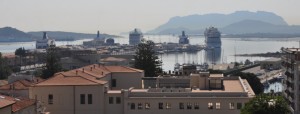 |
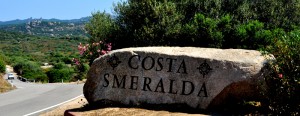 |
Most tourists come here to enjoy the sea and to visit the 50-km long Costa Smeralda which ends at Porto Cervo. The landscape is stunning with granite cliffs and rock formation, unspoilt sandy beaches and bays with crystal clear water in colours ranging emerald green to turquoise and deep blue. We hired a car and hoped to see the best part of the coast and a few archaeological sites in one day.
By the time we set off, it was after 10am. Our driver, a 72-year-old man, speaks English. We had several brief photo (but not swim) stops but I do not think we have seen the most beautiful part of Costa Smeralda. To fully appreciate the landscape and the unspoilt water and beaches, one must spend a few days here soaking in the atmosphere and sea-gazing. I love to explore it with a sailing boat!
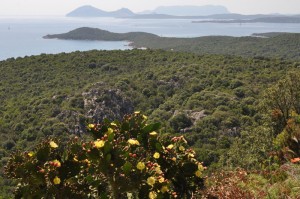 |
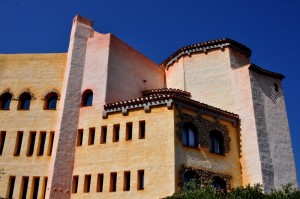 |
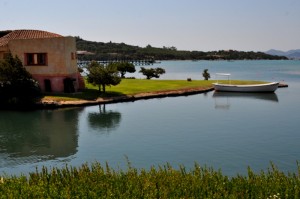 |
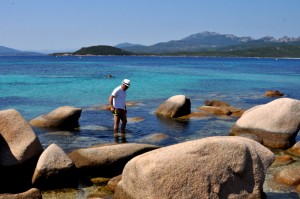 |
Next, we arrived at Palau where visitors can easily reach the archipelago of La Maddalena made up of seven islands. We for a return ticket (€20 each) and the ferry to Island La Maddalena, the largest and inhabited island, onlytook 15 minutes. We could make our way to theMuseum Giuseppe Garibaldi(4thJuly 1807- 2ndJune 1882) where Garibaldi, ‘Father of Italy’ spent his last few years and died. The museum located on the Island Caprera, is about 5km away from the pier. As our car was at Palau and we did not have much time, we decided to return to Palau after an hour. not to take a ferry back to Palau an hour later.
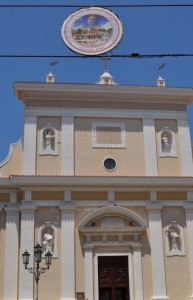 |
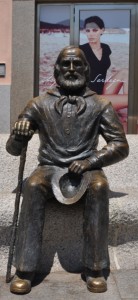 |
Sardinia has plenty of archaeological sites from various civilisations. Today, we only visited three sites in Arzachena on our way back to Olbia. I forget the name of the first nuraghe we visited: it is simple and unimpressive. Our driver did not know the way to the Tombe dei Giganti Coddhu ‘Ecchju (1800-1600 B.C.) and Nuraghe La Prisgiona (1400-1000 BC). Hence, I took on the role of a navigator. We had a good guided tour at the nuraghe which is fairly well preserved with a main tower, an assembly hall and several surrounding structures used for grain storage, baking etc. The village nearby (which has not been excavated) might have 600 inhabitants.
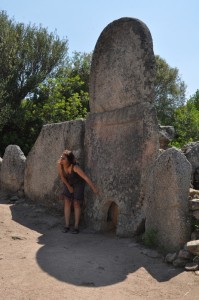 |
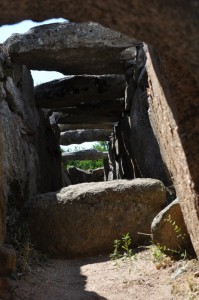 |
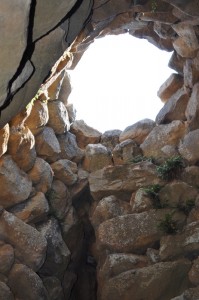 |
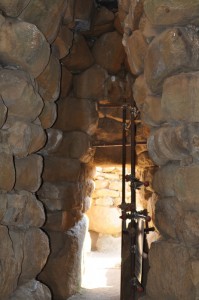 |
We were back in Olbia shortly after 5pm and the driver charged us €170. We do not minding paying but he is not a good guide: he talks without substance and does not know his way or give good advice. Given the limited time available, he could have suggested us bring him and the car to Island La Maddalena so that we could have a complete tour of the island with 20km of paved road and visit Museum Giuseppe Garibaldi and his tomb on Island Caprera. Otherwise, we could skip Island La Maddalena and focus on history and archaeological sites.
In the evening, we walked along Corso Umberto and Via Regina Elena to do shopping and eat. Our dinner at La Corte del Re was simple but excellent with vernaccia wine, anti-pasta, spaghetti with bottarga (dried eggs of mullet), a delicious piazza and a local dessert. We paid less than €100. Good value!
June 6 Saturday: Olbia – Oristano
We kicked off the day with a good breakfast. As the train would not leave till 10:30am, we had time to visit St Paul Church near our hotel. Anyway, we have missed two main attractions, namely the S. Simplicio Church, a Romanic Church first built in 11th century and the Archaeological Museum which displays a few Roman ships discovered during the excavation of the ancient port.
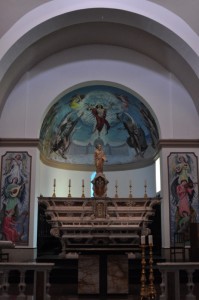 |
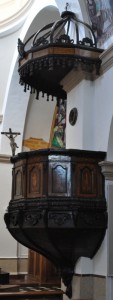 |
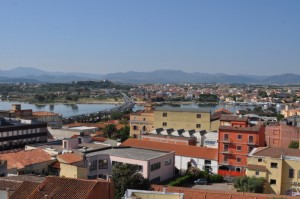 |
Oristano(160km from Olbia and 95km from Cagliari)is famous for its Sa Sartiglia held on the last Sunday and the Tuesday of the carnival. It has a glorious past: in 1070, it became the capital of the Giudicato of Arborea which attempted to conquer the whole island during the reign of (1347-75) of Mariano IV and his daughter Eleanor (1375-1404). The kingdom was conquered by the Aragonese troops in 1478. Today, it has a population of over 32,000 and its economy is mainly based on services, agriculture, tourism and small industries.
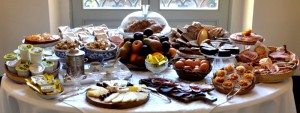 The train journey takes less than three hours. We stayed at Hotel Regina D’Arborea(4-star) located at Piazzo Eleanor D’Arborea. This boutique hotel with only seven rooms,looks like a museum with antique furniture, high ceiling, paintings and heavy curtains. The breakfast is beautifully laid out and most sumptuous! We had a large room (about 60m²) and a painted ceiling with a view from the balcony on the square, Town Hall and the statute of Eleanor of Arborea holding the Carta de Logu.
The train journey takes less than three hours. We stayed at Hotel Regina D’Arborea(4-star) located at Piazzo Eleanor D’Arborea. This boutique hotel with only seven rooms,looks like a museum with antique furniture, high ceiling, paintings and heavy curtains. The breakfast is beautifully laid out and most sumptuous! We had a large room (about 60m²) and a painted ceiling with a view from the balcony on the square, Town Hall and the statute of Eleanor of Arborea holding the Carta de Logu.
Oristano though small has its own charm. One can see the town in a couple of hours. We had a leisure stroll stopping at theSanta Maria Cathedral (1130), the 19m-high Tower of St Cristoforo (1290) built by Mariano IV, Church of San Francesco(around 1200)and the Franciscan church of Santa Chiara (consecrated in 1428). Only the cathedral was open. We also visited the Archaeological Museum “G. Pau” which has fewexhibitsof interest.
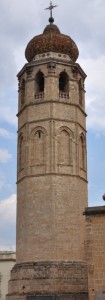 |
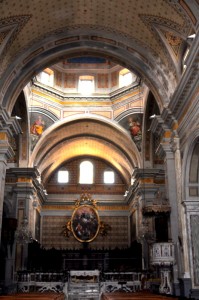 |
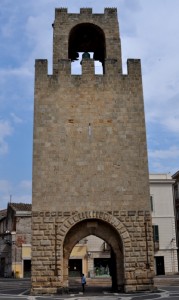 |
We had a sumptuous dinner at Craf a well-established restaurant serving Sardinian cuisine. We had “porceddu” a little sucking pig cooked on the spit on a fire of myrtle (this dish takes three hours to prepare), a starter of the house and a bottle of local wine. An excellent but heavy meal for€102!
June 7 Sunday: A day trip
The hotel arranged a car for us for €200. We had a long day with a pleasant and enthusiastic young driver. Today’s visit was divided into three parts. First, the churches. There are some well-known Romanesque churches in the province of Oristano. At 9:30am, we reached the 12th century Santa Giusta Church which is considered one of the best examples of Romanesque architecture in all of Sardinia. We headed north and stopped in Zeddianl, a small village with an old church. But it is closed for renovation.
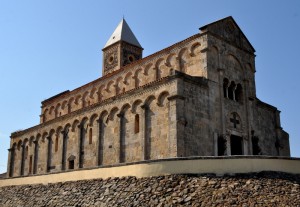 |
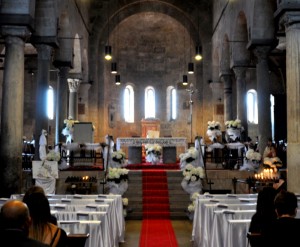 |
We next visited Santa Sofia Church in S. Vero Millis. We saw many women and their children busy preparing for the first communion for children in the village.
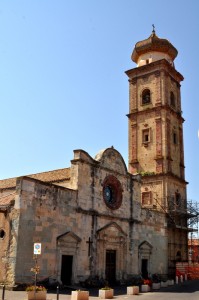 |
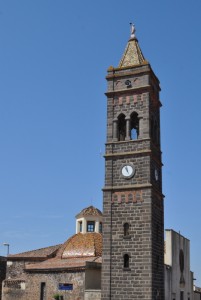 |
Then we arrived in a bigger village, Milesi which church was filled with Sunday church-goers. Finally we stopped at San Paolo Church with a cemetery in Milis. The church was closed but we spent sometime in the atmospheric cemetery.
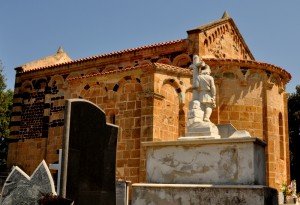 |
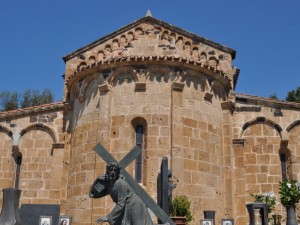 |
Second, the Nuragic complex of Santa Cristina (14 hectares in area)-
- Hypogean Temple of Santa Cristina (Sacred Well) built around 1200/1100 B.C. and made up of three elements – vestibule / hall, stairway in trapezoidal shape with 25 steps and a circular hypogean room with tholos (dome) roof. The hypogean bay of circular plan (2.54m in diametre) is 7,15m high.
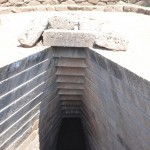 |
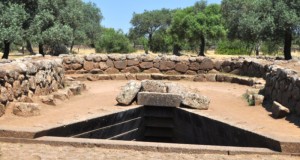 |
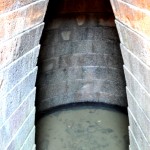 |
- Nuragic village (14th century B.C.) – A single-tower nuraghe with an external diameter of about 13m and a residual height of 7m is still standing. Ruins of the historical nuragic village are visible.
- Christian Village “Santa Cristina” (13th century) lies between the well-shaped temple and the nuraghe with a small church surrounded by houses for pilgrims. The village still celebrates twice a year for nine days in May (second Sunday) and October (the fourth Sunday).
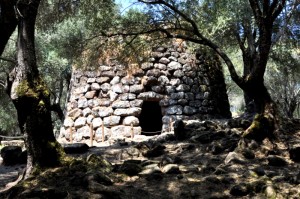 |
We had a quick tour of one more nuraghe which has a more complex structure (I forget the name of this archaeological site).
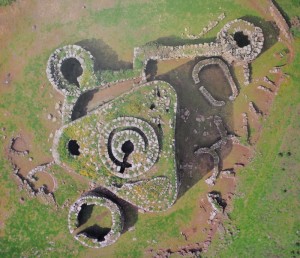 |
Third, Peninsula of Sinis and ruins of Tharros–
First founded by the Phoenicians and later ruled by the Carthaginians, Tharros was abandoned in consequence of Moorish raids when the capital was moved to Oristano in 1070. We first walked to the Tower of S. Giovanni which affords spectacular views of the ruins and the whole area.
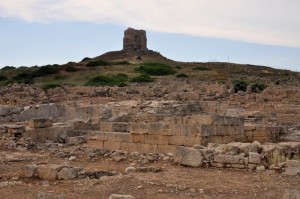 |
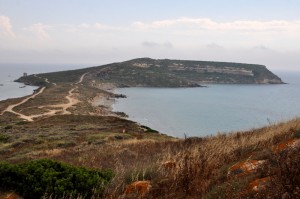 |
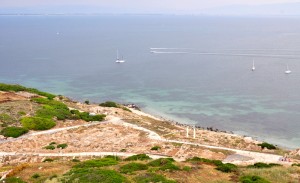 |
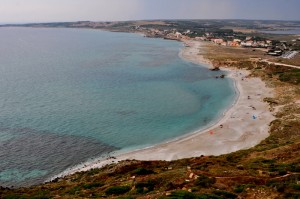 |
We spent half an hour in the ruins. One can easily see a network of roads, underground sewer, fortification, sanctuaries and temples, a baptistery (5th century), two columns, two thermal buildings and some plain houses.
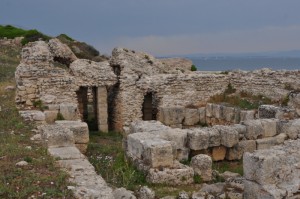 |
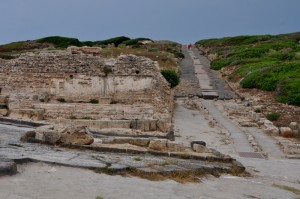 |
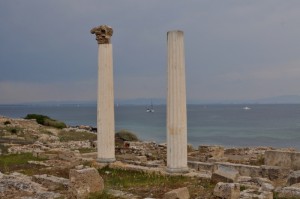 |
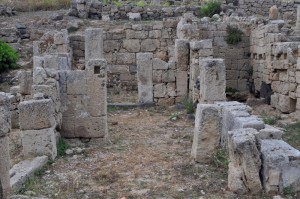 |
On the way back, we had three more stops. The Church of S. Giovanni di Sinis (6th century) built in Romanesque style with low arches and massive tub-shaped vaults is tiny but picturesque. Then we had a brief stop in an old and small village with very traditional stone houses. Finally we reached Cabras, a fishing town on the shore of the lagoon of Cabras which is teeming with eels and mullet.
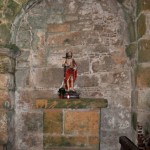 |
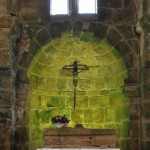 |
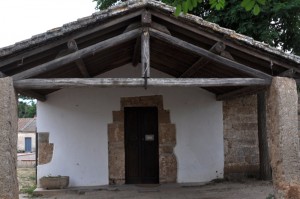 |
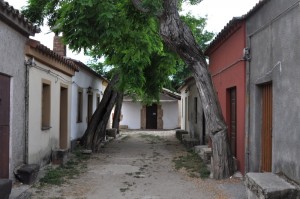 |
Back in Oristano, we saw several beautiful floral presentations of the cross and religious icons on the road. People told us that a procession was about to begin at the cathedral. I know little about Catholicism and its rituals. We arrived just in time to watch hundreds of locals at the cathedral square: men holding banners of guilds/associations were beginning to march. Children/teenagers who had just been baptised followed. Then came various religious bodies including nuns and priests and followed by the archbishop. Men, women and children began to join the procession. We joined the crowd and walked through the old town solemnly for half an hour before returning to the temporary alter set up in front of the residence of the archbishop next to the cathedral.
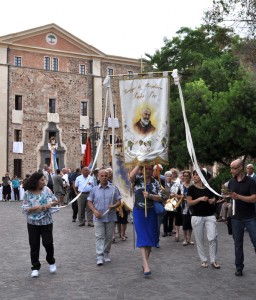 |
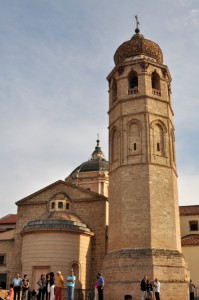 |
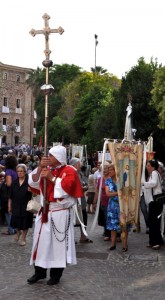 |
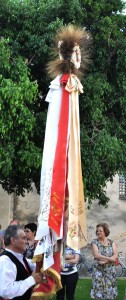 |
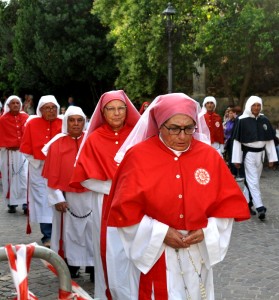 |
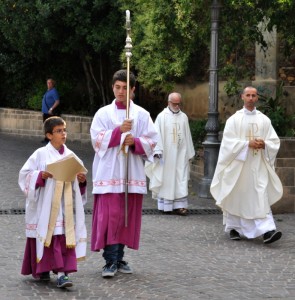 |
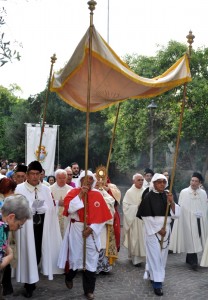 |
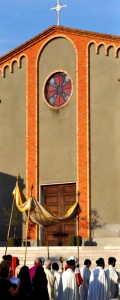 |
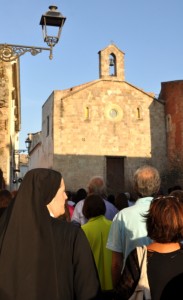 |
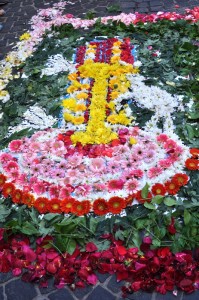 |
The archbishop addressed before entering the cathedral. I followed trying to find out what happened next. A lady who speaks English told me that they were celebrating Corpus Domini(also known as the Feast of Corpus Christi), a Latin Rite liturgical solemnity celebrating the tradition and belief in the body and blood of Jesus Christ and his real presence in the Eucharist. At the end of the holy mass, there is a procession of the Blessed Sacrament which is followed by Benediction of the Blessed Sacrament. We felt blessed and blissful to be able to join such a holy and local event.
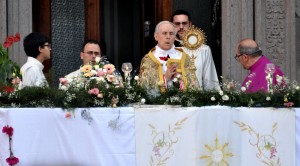 |
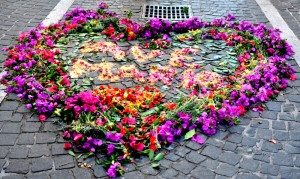 |
The lady also showed me around the cathedral. She explained that of the original structure of Mariano only parts of the apse and base of the campanile are left, as well as the Gothic Chapel of the Rimedio, which houses some medieval sculptures. She pointed one of the sculptures near the entrance of the cathedral was by Pisano. The current Baroque style is largely from the 19th century restoration.
June 8 Monday: Oristano – Cagliari
After having a wonderful breakfast, we took a taxi to the train station. The journey to Cagliari takes less than two hours. Cagliari, an ancient city inhabited for over 5,000 years, has been the rule of several civilisations as evidenced by the ruins and structures includingnecropolis, roman amphitheatre and villa, castles etc. Given its strategic location, it was the capital of the Kingdom of Sardinia from 1324 (which marks the end of the Giudicati of Cagliari) to 1848. Today, it is the capital of Sardinia with a population of over 420,000 in its metropolitan area. It is also a regional, cultural and educational centre and an economic and industrial hub in the Mediterranean Sea.
Our hotel located near Porto Scalas, is about 15 minutes’ walk from the train station. After leaving our luggage in the hotel, we walked to Piazza Yenne, heart of the city, strolled along Via Manno, the main shopping street before reaching the Bastione San Remy. Unfortunately, the place is under restoration and we could not reach the upper part of the old town through the staircase. We had to walk along Via Regina Elena before taking a lift which goes to Piazza Palazzo.
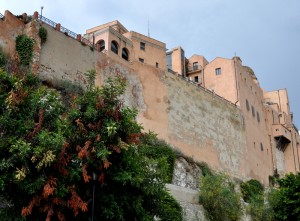 |
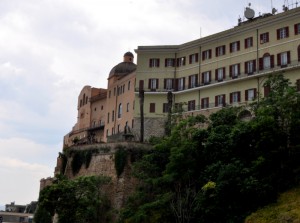 |
The upper part of the town is small with five main streets running from the bastion to the Citadel of Museums. We walked past Piazza Indipendenza and Piazza Arsenale and saw Torre di San Pancrazio (the second big defensive tower built around 1307) before arriving at the Archaeological Museum which as expected closes on Monday.
Suddenly, the sky blackened with lightning and thunders. Despite our umbrella, we got wet owing to the heavy downpour. We had to take shelter in an old-styled café: three lemon tea and a sandwich cost €20 (not value-for-money). Once the rain stopped, we went to theCathedral of Santa Maria (13th century) at Piazza Palazzo.
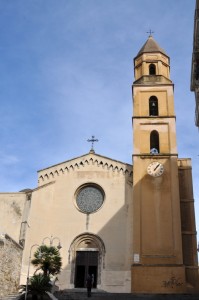 |
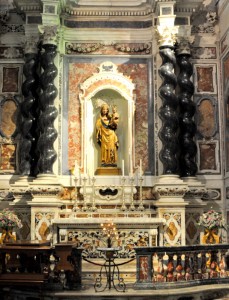 |
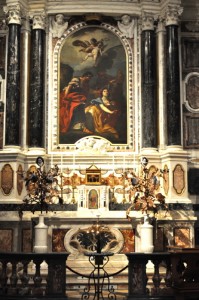 |
We were in no mood to walk around as we were wet and chilly. It was still raining when we reached the hotel. When we came out again after 4:30pm, the sky had cleared up with blue sky and sunshine! This time we explored the lower part of the city, in particular the area bounded by Via Roma, Largo Carlos Felice, Via Manno and Via Regina Margherita.
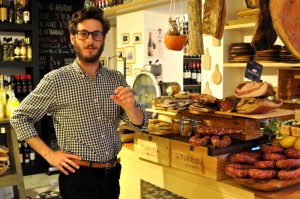 |
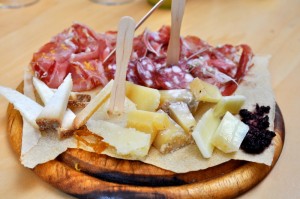 |
We enjoying looking at small local shops and back lanes. A shop ‘Sapori di Sardegna‘ in a side street off Via Roma, suddenly caught our attention. We went in and had a happy time tasting wine and food. After having a glass of red wine and prosciutto, we spent over €100 on salami, ham, black spaghetti and bottarga. The owner in return did not charge us for the wine and food (€15)! On his recommendation, we had dinner in a restaurant on Via Sardegna. But the seafood was disappointing.
June 9 Tuesday: A day trip
As a World Heritage Sites enthusiast, I am determined to see the Nuragic complex Su Nuraxi which is the most important architectural expression of the Sardinian megalithic civilisation. Ellen and Denise who had already seen three nuraghe, preferred a leisure sightseeing day in Cagliari. I tried to look for an organised day trip as a private car would cost €120-150. But I could not find a tour and someone suggested me wait at a tourist bus stop at 9am since I might find other passengers heading the same way.
Ellen and Denise are too kind and considerate to leave me alone: they decided to go as well. Once again, we took a private car with a young and nice driver, Marco. We set off at 9am and our first stop was the San Benedict Marketfamous for fresh produces. We had a fun time trying cheese, salami, bottarga etc. Once again, Ellen and Denise brought a lot of food stuff. I only spent €2 on radish and pig knuckle.
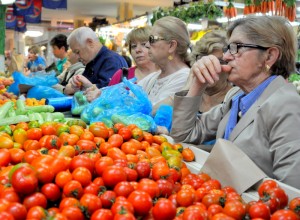 |
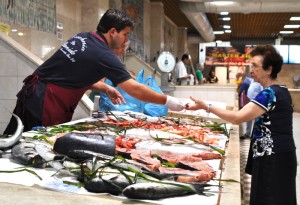 |
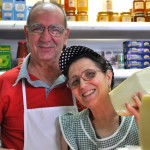 |
 |
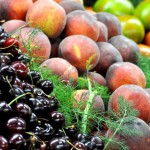 |
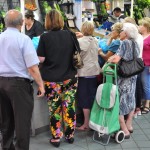 |
At 11am, we headed to Barumini, 60km from the capital. The highway is very good and the landscape with valleys under cultivation and plateau is very green and beautiful. Su Nuraxi lying just outside Barumini is a ‘must-see‘. The fortress dating to 15th century B.C., is formed by a central tower made of blocks of basalt. A rampart was added a couple of centuries later with a tower at each corner and a courtyard with a 20m deep pit. Finally the bastion was reinforced with a thick wall blocking the original access between the southern and eastern towers. The whole structure was surrounded by an octagonal wall with seven towers at the corners. There is anuragic village nearby (dating around 12th century B.C.).
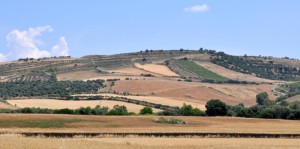 |
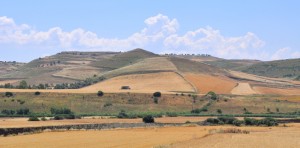 |
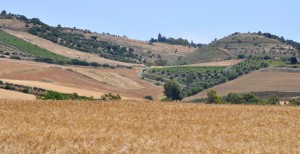 |
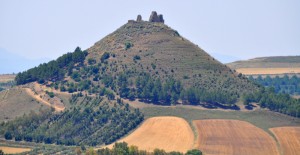 |
All visitors have to take a guided tour which starts every 30 minutes. We had a good guide who gives lots of information. Visitors have to descend into the central courtyard through a very narrow and steep staircase. Few visitors were afraid of falling and turned back. But only by getting into the courtyard and seeing the internal structures can a visitor fully appreciate the engineering achievements and wisdom of the builders some 3,500 years ago! Views from the tower of the surrounding countryside is stunning. The guide also suggested a visit to the largest Giants’ Tomb near Siddi.
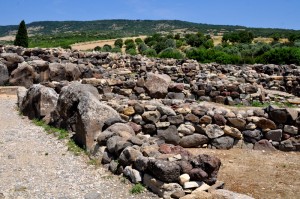 |
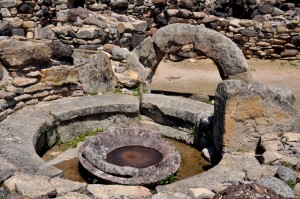 |
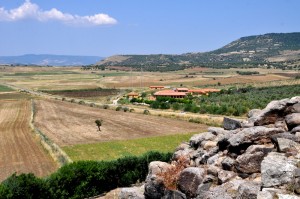 |
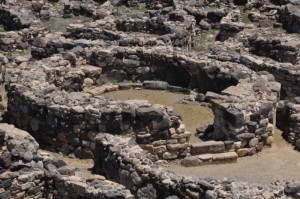 |
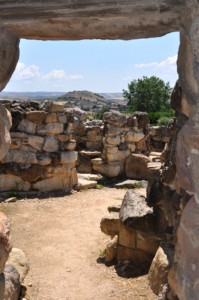 |
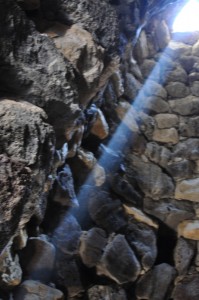 |
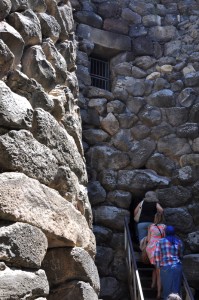 |
We then visited the Casa Zapata Museum, a complex mounted into a noble residence built in the 16th century by the Zapata family from Aragon. The museum now consists of three sections – an archaeological section where visitors can see some Nuragic stone structures through glass floors, a historical section telling the history of this family and an ethnographic section.
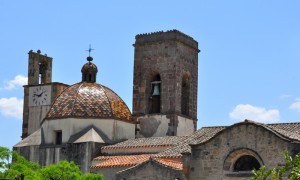 |
We followed the guide’s suggestion and Marco tried his best to find the Giants’ Tomb. We finally found it after having got lost a few times. Different from the Tombe dei Giganti Coddhu ‘Ecchju, it looks more like a big house on top of a plateau. Anyway, the views are fabulous. A bonus!
Before returning to the hotel, Marco took us to the Flamingo‘s Park of Molentargius where we saw over a hundred flamingos in the lagoon. Our tour ended at 6pm. We paid €200 for a full day private tour in a luxurious Benz saloon car. Great value!
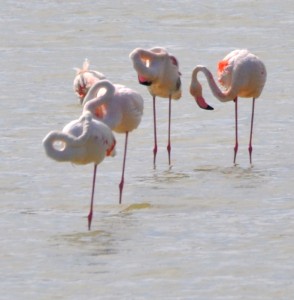 |
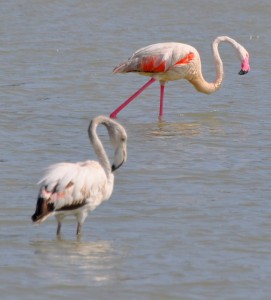 |
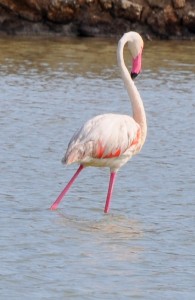 |
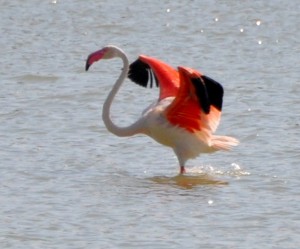 |
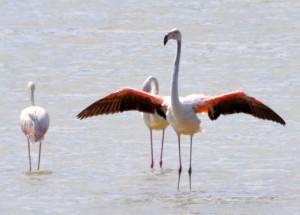 |
As the weather was good, we ventured out immediately. After visiting three churches (S Michele, S Anna and S Chiara), we took a lift next to Church S Chiara to the upper part of the town for the second time. We entered from the impressive Torre dell’ Elefante (the first defense tower built by Pisans in 1307) and stopped at the Church of Holy Cross, Piazza Palazzo and the cathedral and walked back to the lower part of the town from the Lion Gate.
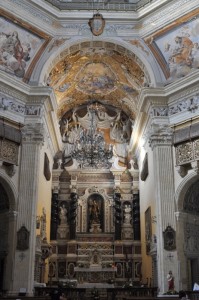 |
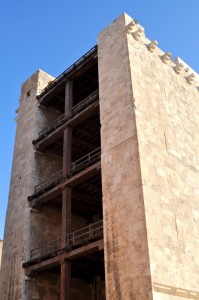 |
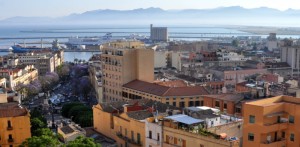 |
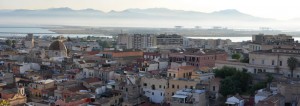 |
It was 8pm. We had dinner at Da Marino al St Remy at Via Torino. We had three delicious dishes (a seafood soup, pasta with bottarga, beef and half a bottle of local wine) for €90. The portion is fairly small but the quality of food and service are excellent.
June 10 Wednesday: Cagliari, Sardinia – Rome – Geneva, Switzerland
We had an early start as our flight to Rome was at 7:45am. While Denise and Ellen returned to Hong Kong, I moved onto Switzerland. My connecting flight to Geneva took off at 9:55am.
I had a fantastic (though rush) trip in Italy with good company and excellent food. Everything has gone well though we have missed out many highlights in Sardinia!


